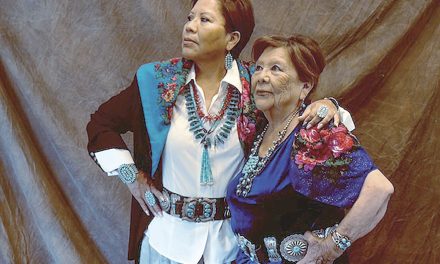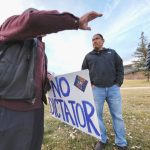
Change in tribal budget process could shut down government
WINDOW ROCK
A tussle between the Budget and Finance Committee and the Navajo Nation Office of the President and Vice President may cause a government shutdown if a technicality in tribal law is not remedied.
On Wednesday, the president’s office issued a memorandum, a notice required by law to its division directors informing them of the possible shutdown and to make plans on how they would work around it.
The scuffle began in June, according to a Navajo Office of Management and Budget memorandum addressed to Attorney General Ethel Branch, asking for clarification if BFC was the only authority to establish the three branch base planning allocations to prepare the fiscal 2025 comprehensive budget.
Base planning amounts refer to the specifically allocated funds designated for each of the three branches of government, which are detailed as three distinct dollar figures. These amounts are crucial for each branch as they prepare their budgets for various programs and chapters for the upcoming fiscal year.
“If not, what authority does the BFC have in allocating the base planning amounts?” the OMB asked Branch.
On June 18, the Budget and Finance Committee approved the plans and allocations of projected revenue for the fiscal 2025 comprehensive budget.
Three days later, on June 21, President Buu Nygren, Speaker Crystalyne Curley, and Justice JoAnne Jayne met and agreed to allocations that were signed the agreement three days after their meeting.
Comprehensive budget
According to the signed Navajo Nation Three Branch Chiefs’ Agreement, fiscal 2025 comprehensive budget, the Executive Branch would have been allocated $130,990,750, the Legislative Branch would have been allocated $20,159,261, and the Judicial Branch would have been allocated $20,201,266.
The rest of the comprehensive budget, for $51,061,723, would have been allocated to the chapters-non-administrative, the external funds cash match, and the fixed costs. Overall, the total amount the three branch chiefs agreed on was $222,413,000.
Funding for each governmental entity would come from the General Revenue Projection and Permanent Fund Interest.
What should have been a usual budget approval process after President Nygren, Speaker Curley, and Justice Jayne agreed on a comprehensive budget in June, which then was given to the BFC as their recommendations for the 2025 fiscal year budget, instead turned into a grudge match for who will have overall authority over the fiscal budget process.
What the BFC did was cross out a section in the budgeting process known as BIM, or Budget Instruction Manual, in resolution BFJY-17-24, Section 6(A) of the BIM, which originally states that the three branch chiefs make fiscal year budget recommendations to BFC which then decide to approve or disapprove through a resolution. If the recommended fiscal year budget is approved, the three branch chiefs then use the funding according to their programs within their respective branches.
Amending language
BFC amended language in BFJY-17-24, Section 6(A) of the BIM, and changed it to “BFC establishes the Base Planning Allocations each fiscal year, the “Navajo Nation programs use the Base Planning Allocations to prepare their fiscal year budgets,” which are under Title 12 of the Navajo Nation Code.
To make matters more confusing, instead of the agreed $222,413,000 2025 fiscal year budget the three branch chiefs agreed on with their signatures on June 21, the BFC approved a budget for $202,923,866, which was off by $19,489,134.
According to resolution BFJY-17-24, which BFC established to rescind resolution BFJN-16-24 entirely after the Office of Management and Budget presented to them how much unspent was still available to each branch, found that “the reduction in projected revenues for FY 2026, the underspending of all branches of all Navajo Nation Branches, and the budget transfer documentation, all warrant a departure from the Three Branch Chiefs’ agreement.”
According to the BFC resolution, the executive branch had more than $8.1 million, legislative had nearly $1.1 million, and judicial had over 325,000 dollars in budget transfers.
“The Budget and Finance Committee hereby rescinds Resolution No. BFJN-16-24 in its entirety,” resolution BFJY-17-24 reads.
Based on those findings, BFC approved a budget worth nearly $203 million. In the new BFC-approved budget, the executive branch would now get $117,327,379, the legislative branch would get $18,056,491, and the judicial branch would get $18,094,114.
Overall authority over fiscal budget
During the approval process, when it reached OMB’s desk, they noticed the discrepancy, according to the Branch’s July 16 memorandum, and presented questions to Navajo DOJ, asking who has overall authority over the tribal government’s fiscal year budget.
“This year during the FY 2025 budget planning process, the BFC also, for the first time in recent memory, departed from the Three Branch Chiefs’ recommendation by not utilizing the full Revenue Projection for the coming Fiscal Year in developing the FY 2025 General Fund Budget Amount and Base Planning Allocations. Instead, the BFC used the prior Fiscal Year’s information,” the AG’s memo read. “It is unclear why the BFC departed from prior practice in this regard, and it raises a question of whether the BFC had the authority to do so. A forthcoming analysis under Diné Fundamental Law will address this question of authority.”
On Aug. 7, the Branch issued an opinion in response to the OMB, about OMB’s request for clarification.
“Does the BFC have the exclusive authority to set the Base Planning Allocations without meaningful consultation with the Branch Chiefs? If not, what is the legal consequence of not having meaningful consultations with the Branch Chiefs? As the governing body of the Navajo Nation, can the Navajo Nation Council amend the law to eliminate the meaningful consultation requirement?” Branch’s opinion read.
Branch said the BFC did not.
“No. The BFC does not have exclusive authority to set the Base Planning Allocations without prior meaningful consultations with the Branch Chiefs. Amending the Budget Instructions Manual (the “BIM”) does not eliminate this requirement because the balance of power in the budget process is established in organic Navajo Nation law that can only be changed by the Navajo People,” the AG’s opinion read.
According to Branch’s opinion, under Title 2 of the Navajo Nation Code, the attorney general is the chief legal officer of the Navajo Nation and issues legal opinions.
“No adverse action may be taken by the Navajo Nation government against any official or employee of the Navajo Nation government who follows the advice contained in this Opinion,” the opinion cited.
The opinion was given due to concerns over the passage of Resolution BFJY-17-24, which invalidates the Base Planning Allocations approved in Resolution BFJY-17-24.
Branch’s opinion carries the force of law
The AG’s opinion, which is intended to guide legal processes within the Nation, has been overlooked by the BFC, according to Kris Beecher, the president’s deputy chief.
Branch’s opinion carries the force of law, said Beecher on Thursday at his office in Window Rock, making it essential for navigating the complex legal landscape that governs the Nation’s finances.
Unlike many other tribal governments, the Navajo Nation is legally required to maintain a transparent budget, which is intricately linked to its financial statements and audits. With $9 billion in assets and $150 million in liabilities, the Nation currently operates on a budget of more than $200 million.
Failure to pass budget could result in layoffs
However, the urgency is palpable, as failure to pass the budget by Oct. 1, could result in layoffs, said Beecher, adding that in light of the challenges, there is a push for the Navajo Nation to leverage its available funds. Without a proactive approach to financial management, the potential for layoffs and reduced services poses daunting challenges to the well-being of the Navajo people.
If a budget is not passed, it could severely impact funding and services across the executive, judicial, and legislative branches, cited Beecher. The potential consequences have raised concerns about the long-term sustainability of vital programs for the Navajo people.
The executive branch is made up of divisions with nearly 4,000 employees. The executive branch and the judicial branch provide direct services to the Navajo people by way of human resources, social services, housing, road construction and maintenance, scholarships, operations of the Navajo Nation counts, and implementation of other numerous projects.
Nygren wrote a presidential fiscal 2025 budget message on Aug. 26, to Speaker Curley, stating his priorities were housing, road construction and maintenance, scholarships, and elder support.
“By not moving the Comprehensive Budget forward we risk either the passage of a Continuing Resolution on a government shutdown – both of which are unacceptable as both have drawbacks,” Nygren’s statement read.
The reliance on a continuing resolution instead of a comprehensive budget raises significant concerns for students and various programs within the Nation, Nygren wrote to Curley.
He added that with partial funding in place, full scholarships may not be disbursed, forcing some students to withdraw from or delay their classes, not only affecting students’ education but also undermining the stability of ongoing academic programs.
Beecher said he’s hopeful a budget, whether for three months or 12 months, will be passed to prevent a government shutdown.
“I’m hopeful that they’ll get it done. I’m hopeful that they’ll give us something. A comprehensive budget is different than a continuing resolution, but I think that if they give the minimal amount, which I think would probably be a three-month resolution,” Beecher said on Thursday. “A continuing resolution would help us get to where we need to be with the comprehensive budget, but that said, there are negative aspects of just doing a continuing resolution.”
On Thursday, the Council held a Naabik’íyáti’ Committee meeting for over nine hours where they heard from the Navajo Nation Veterans Administration and discussed funding for Navajo veteran homes, and ongoing bathroom addition projects the Navajo Engineering Construction Authority was working on. A budget to keep the tribal government from shutting down was not discussed during the meeting.








 Highway 264,
Highway 264, I-40, WB @ Winslow
I-40, WB @ Winslow